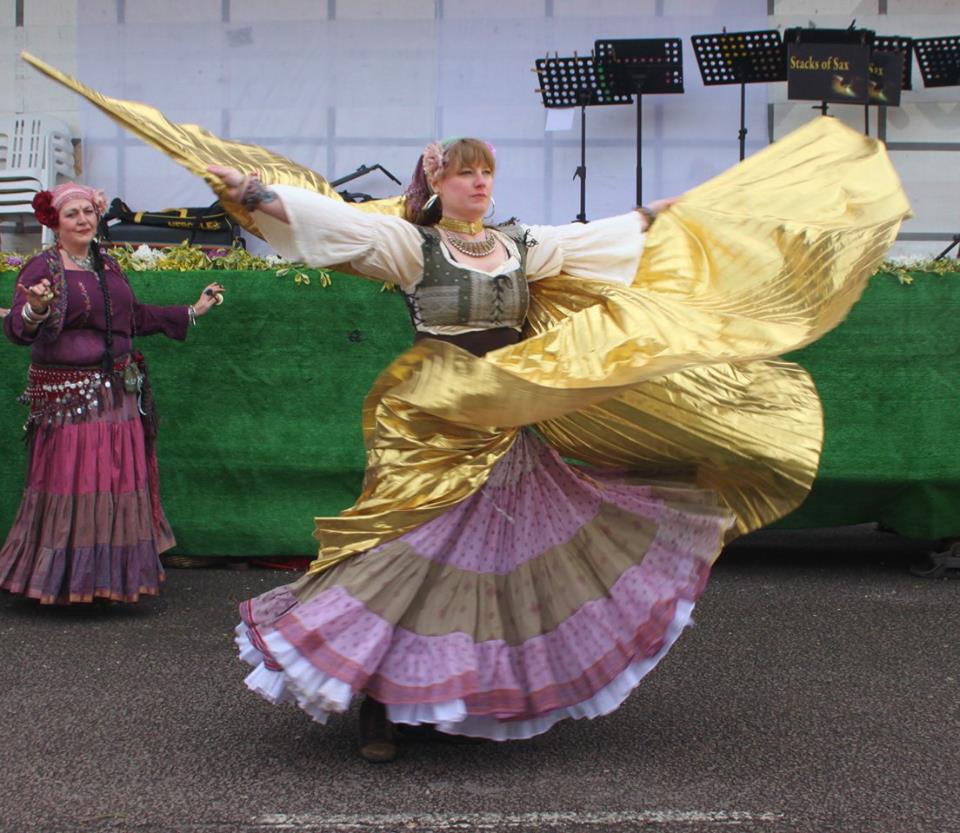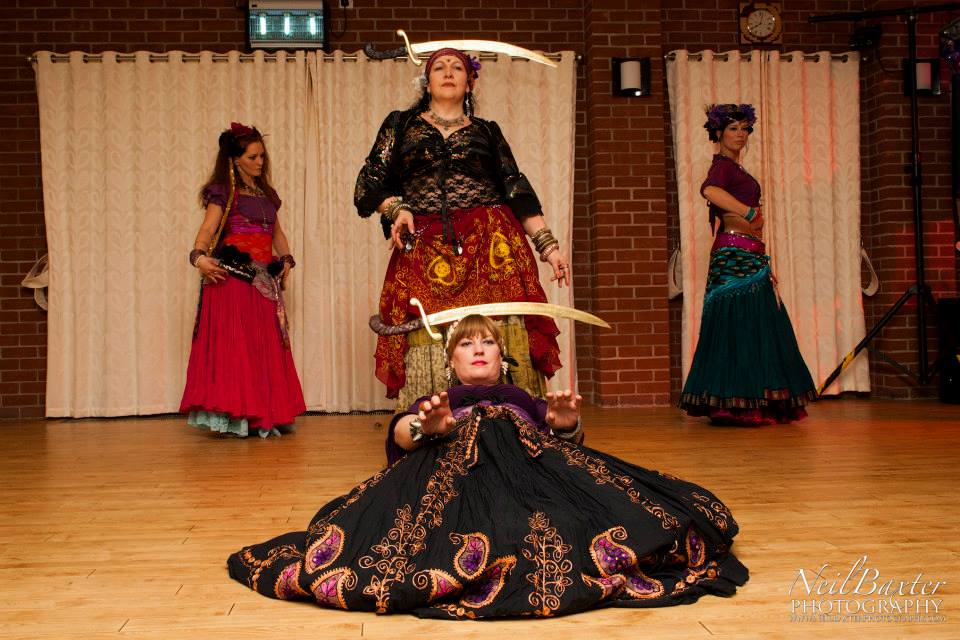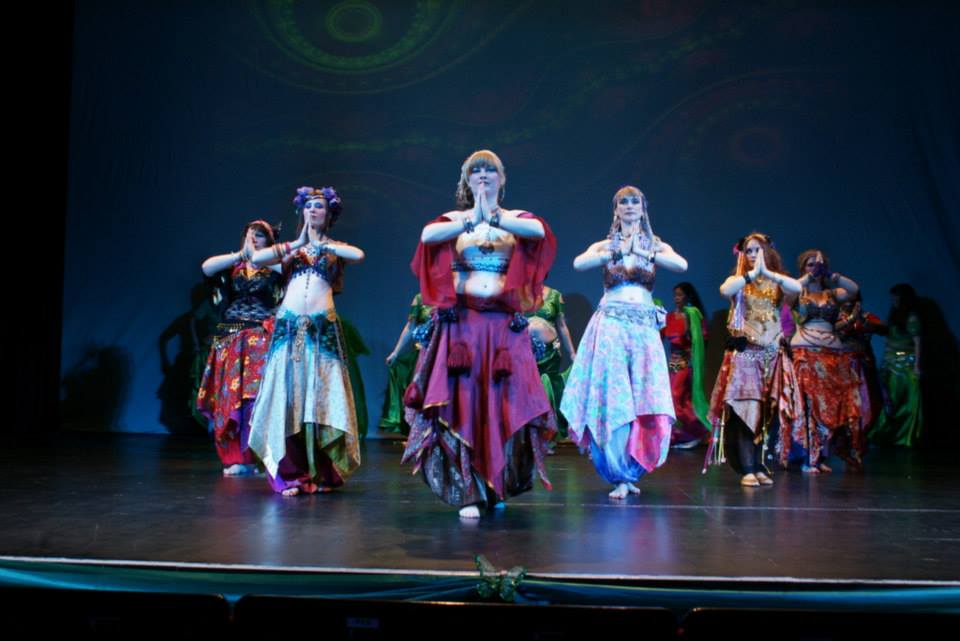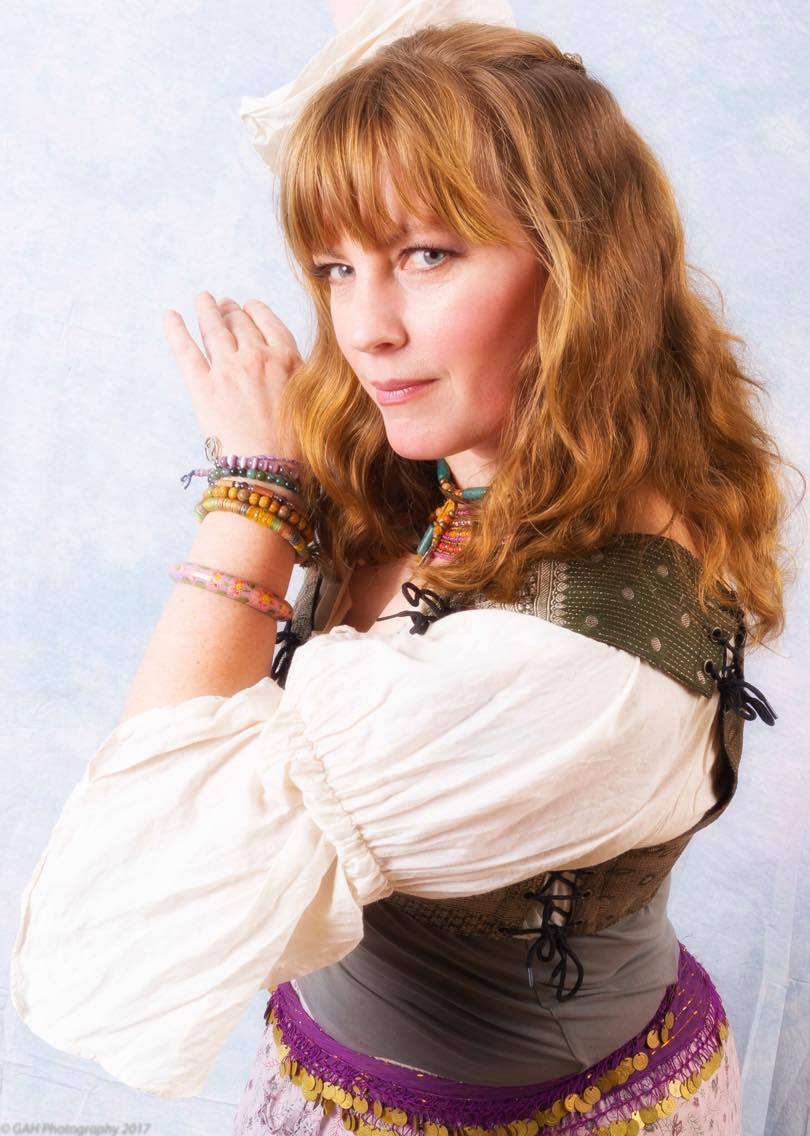 Belly dance is a Western term for a traditional Arab dance genre known as raqs sharqi - literally "oriental dance") or sometimes raqs baladi - literally "dance of country", (and so "folk" dance). It is also sometimes called "Middle Eastern Dance" or the "Arabic Dance" in the United States, "danse du ventre", or by the Turkish term Çiftetelli.
Belly dance is a Western term for a traditional Arab dance genre known as raqs sharqi - literally "oriental dance") or sometimes raqs baladi - literally "dance of country", (and so "folk" dance). It is also sometimes called "Middle Eastern Dance" or the "Arabic Dance" in the United States, "danse du ventre", or by the Turkish term Çiftetelli.
Native to the Middle East, and now popular worldwide, belly dance takes many different regional forms, both in costume and dance style, indicating that distinctive dance moves may have been transported to these regions and incorporated with local dance styles.
Today there are two forms of Oriental belly dance. The first is called raqs baladi, a social dance performed for fun and celebration by men and women of all ages, usually during festive occasions such as weddings and other social gatherings. The second form, the more theatrical and the more popular in the West today, is called raqs sharqi. Like raqs baladi, raqs sharqi is performed by both male and female dancers. In regions where belly dancing is native, boys and girls learn it informally from an early age by observing and imitating their elders during family/community celebrations and gatherings with friends.
Belly dancing was originally from Ancient Babylon in southern Iraq. Adnanite Arabs introduced belly dancing and drumming. Belly dancing was passed on from generation to generation. The drum beats people hear today are the same beats that the Arab tribal men used. Before the arrival of Islam the tribes in Arabia used to gather women in private gatherings or special occasions and perform the belly-dancing, while men from the tribe perform on the drum.
During the time of the Abbasid and the Fatimid dynasties, the Arabs settled in Egypt and passed on the belly dance. Since that time, the Egyptians adopted the dance and it was passed on through generations. Egyptians have been known for having good belly dancers.
 There is also some evidence that belly dancing is a reworking of movements traditionally utilized to demonstrate or ease childbirth. There are numerous oral historical references, backed by commentary in The Dancer of Shamahka. This particularly relates to a sub-set of dance movements found in modern raqs sharqi.
There is also some evidence that belly dancing is a reworking of movements traditionally utilized to demonstrate or ease childbirth. There are numerous oral historical references, backed by commentary in The Dancer of Shamahka. This particularly relates to a sub-set of dance movements found in modern raqs sharqi.
Most of the basic steps and techniques used in belly dancing involve circular motions isolated to a certain part of the body. For example, a circular movement "drawn" parallel to the floor by the hips is known as a "hip circle", or by the rib-cage known as a "chest circle". Accents such as "hip lifts" or "drops" are use to draw the eye to hip movement such as "shimmies or hip circles", while shoulder or arm movements are to accent chest or belly undulations. Dancers often dance while balancing various props like baskets, swords or canes(canes in particular for folkloric dances.)as well as using silk or chiffon veils and wings for dramatic dance pieces.
Raqs Sharqi belly dancing consists of movements that are executed throughout the body. The focus of the dance is the pelvic and hip area. It is, fundamentally, a solo improvisational dance with its own unique dance vocabulary that is fluidly integrated with the music’s rhythm.
Raqs Sharqi dancers internalize and express the emotions evoked by the lyrics and the music. Appropriately, the music is integral to the dance. The most admired Raqs Sharqi dancers are those who can best project their emotions through dance, even if their dance is made up of simple movements. The dancer’s goal is to visually communicate to the audience the emotion and rhythm of the music. Raqs Sharqi translates from Arabic as "dance of the Orient" or "Oriental Dance". Belly dance is a misnomer as the all parts of the body are involved in the dance, and the most important body part is the hips. The dancer’s goal is to visually communicate to the audience the emotion and rhythm of the music.
Many see Raqs Sharqi as a woman's dance, celebrating the sensuality and power of being a mature woman. A common school of thought believes that young dancers have limited life experience to use as a catalyst for dance. Sohair Zaki, Fifi Abdou, Lucy, Nagua Fouad, Jillina, Dina are all popular Egyptian dancers above the age of forty (as well as Rachel Brice on June 15 2012 - happy 40th!).
Outside the Middle East, raqs sharqi dancing was popularized during the Romantic movement of the 18th and 19th centuries, whereby Orientalist artists depicted their interpretations of harem life in the Ottoman Empire. Around this time, dancers from different Middle Eastern countries began to perform at various World Fairs. They often drew crowds that rivaled those of the technology exhibits.
 The term "belly dancing" is generally credited to Sol Bloom, entertainment director of the 1893 World's Fair, the World Columbian Exposition in Chicago. Although there were dancers of this type present at the 1876 Centennial in Philadelphia, it was not until the 1893 fair that it gained national attention. There were authentic dancers from several Middle Eastern and North African countries, including Syria, Turkey and Algeria, but it was the dancers in the Egyptian Theater of The Street in Cairo exhibit who gained the most notoriety. The rapid hip movements and the fact that the dancers were uncorseted, was considered shocking to the Victorian sensibilities of the day. In fact, there were attempts by many, most notably Anthony Comstock, head of the New York Society for the Suppression of Vice, to have the Egyptian theater closed.
The term "belly dancing" is generally credited to Sol Bloom, entertainment director of the 1893 World's Fair, the World Columbian Exposition in Chicago. Although there were dancers of this type present at the 1876 Centennial in Philadelphia, it was not until the 1893 fair that it gained national attention. There were authentic dancers from several Middle Eastern and North African countries, including Syria, Turkey and Algeria, but it was the dancers in the Egyptian Theater of The Street in Cairo exhibit who gained the most notoriety. The rapid hip movements and the fact that the dancers were uncorseted, was considered shocking to the Victorian sensibilities of the day. In fact, there were attempts by many, most notably Anthony Comstock, head of the New York Society for the Suppression of Vice, to have the Egyptian theater closed.
A recent movement in the U.S. called American Tribal Style Belly Dance, or ATS, represents everything from folklore-inspired dances to the fusion of ancient dance techniques from North India, the Middle East, and Africa. Created in 1987 by Carolena Nericcio, founder of FatChanceBellydance in San Francisco, ATS has a format consisting of a vocabulary of steps that are designed to be performed improvisationally in a lead-follow manner. ATS is performed in a group, typically with a chorus of dancers using zills, or finger cymbals, as accompaniment. The music can be folkloric or modern, and the costume is heavily layered, evoking traditions of any or all of its fusion of cultural influences.
With its growing popularity in the western world, belly dance classes are thriving throughout the UK and Ireland, though the belly dance culture has been evidenced since the early 1960s, with many styles being taught including traditional, modern, tribal, Persian, Oriental, Turkish, Greek, Egyptian, American Tribal.
GYPSY FUSION BELLY DANCE
 This belly dance style is a broad and liberal interpretation of the performance and folk dances of the 'Gypsy' (more properly called Rom, Roma or Romani) people, primarily from Turkey, Spain, the Balkans, and Egypt. It is believed that the Romani originated in northern India. They migrated north and east into the Middle East and Europe, evolving their original dance style by incorporating elements of each culture they came in contact with. In the 1960s, American bellydancers started incorporating Gypsy costume elements, music, and folk steps into their own bellydancing.
This belly dance style is a broad and liberal interpretation of the performance and folk dances of the 'Gypsy' (more properly called Rom, Roma or Romani) people, primarily from Turkey, Spain, the Balkans, and Egypt. It is believed that the Romani originated in northern India. They migrated north and east into the Middle East and Europe, evolving their original dance style by incorporating elements of each culture they came in contact with. In the 1960s, American bellydancers started incorporating Gypsy costume elements, music, and folk steps into their own bellydancing.
The Moves: Gypsy uses the core belly dance moves vocabulary and belly dance techniques of classic bellydance with the addition of other elements, including Roma and Middle Eastern folkloric steps. The dance is known for its passion, exuberance, and high energy. There is often the use of props such as tambourines and finger cymbals. Skirt work is now very popular in Gypsy bellydance, but was not acceptable among many Roma dancers in the past.
Music: Some pure, traditional Roma music is used for Gypsy bellydance, but more often the music is a blend of Gypsy/Roma, Turkish, Arabic, and European folkloric elements. Violins, guitars, and tambourines are some common instruments.
Costume: Heavy opaque fabrics are used in voluminous skirts and 'harem' pants. These are paired with vests and/or blouses (many with billowy sleeves). A Gypsy bellydancer's midriff is often uncovered, but not always. The skirts often have ruffles (like Flamenco, a related dance) and bold patterns and colors are common. Hip accents are often fringed shawls and/or metal hip belts. Long headscarves can be used as well generous displays of ethnic jewelry.
We at Wild Rose honour all the ethnic traditions that have created this fusion dance style.